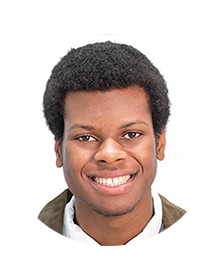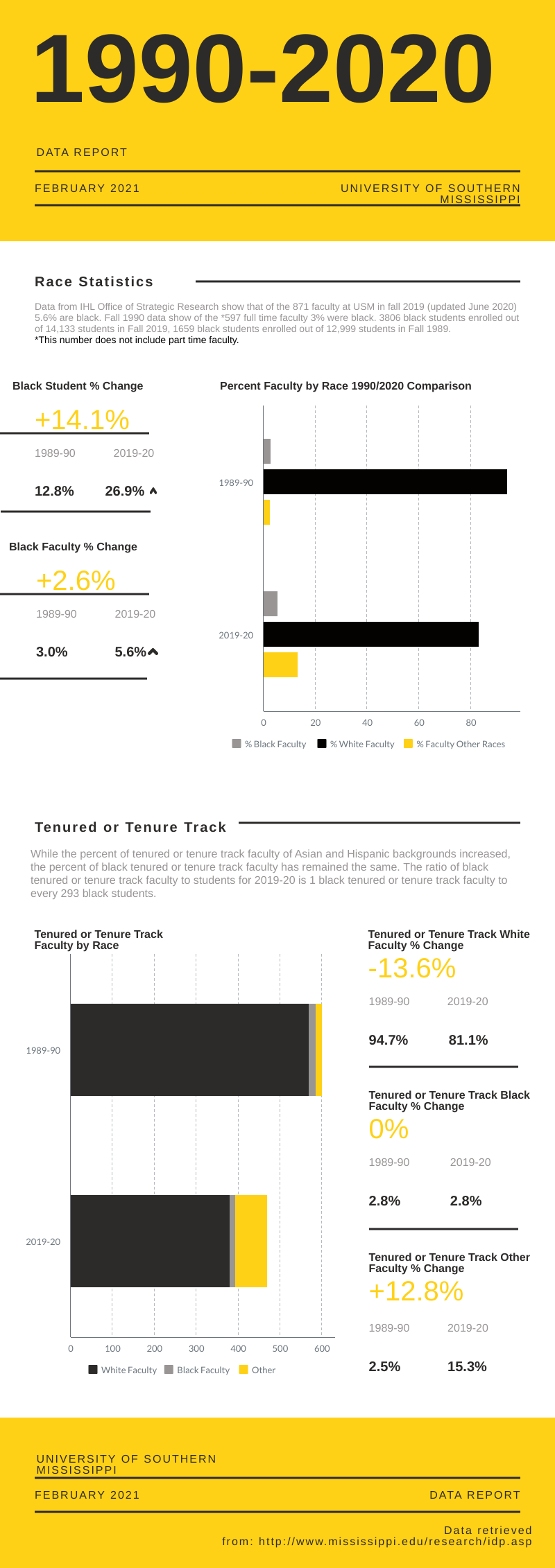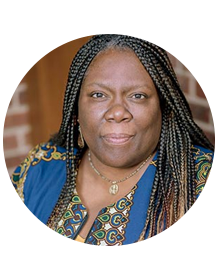Black Students & Faculty
Black Faculty
“Fill the Gap: Black Students AND Black Faculty Matter”
By Earl Stoudemire, ’21
Although the percentage of Black students at the University of Southern Mississippi has more than doubled over the past 30 years, that is not the case for full-time Black faculty.
Regarding students, in fall 1990, 12.6% enrolled at Southern Miss were Black. That’s 1,702 out of 13,492 students, according to the Mississippi Institutions of Higher Learning (IHL). In fall 2019 (updated Juned 2020), 26.9% of Southern Miss students were Black. That’s 3,806 out of 14,133, IHL data show.
Regarding faculty, in fall 1990, 3% (18) of the 597 full-time faculty were Black, according to IHL. In fall 2019 (updated June 2020), 5.6% (32) of the 871 Southern Miss faculty are Black.
Nationally, about 5.5% of full-time faculty members are Black compared with about 14% of their students, according to the National Center for Education Statistics and Inside Higher Ed.
However, at Southern Miss, there are 5.6% Black faculty compared with 26.9% Black students, IHL data show. Note that this comparison includes part-time and full-time Black faculty, which means the number of full-time Black faculty is well below the national comparison.
While the overall student-to-faculty ratio was 17-to-1 at Southern Miss during the 2019-20 academic year, the ratio of Black students to Black faculty was 78-to-1 during the same time period. This includes 49 full-time and part-time Black faculty.
Faculty of color at PWIs
The consequences for the lack of a diverse faculty, especially Black professors, can be detrimental for generations of students, especially at predominantly white institutions (PWIs).
In “On the Importance of African-American Faculty in Higher Education,” surveys show that faculty of color valued teaching, scholarship, and a focus on learning more than their white counterparts, based on research by Na’im Madyun, Shenek M. Williams, Ebony O. McGee, and Richard H. Milner IV.
The article also points out that faculty of color were more likely than white faculty to place great importance on students’ outlook in life.
Samantha Manaway, a senior McNair Scholar studying Child and Family Studies from Hattiesburg, is researching Black child development. Manaway reflects on her experience having a Black instructor critical in her professional development.
“She did not want Black women downgrading themselves. She spoke that out in class. She wanted us to dress appropriately in class,” Manaway said. “This shocked me because we’re supposed to be grown, but as a professor I can see where she was going with this because what people see about us is their first impression. She made me think about my appearance no matter where I go or for how long.”
Na’im Madyun, in collaboration with other researchers, supports the idea of building and improving intercultural competence when more faculty of color come into PWIs.
Intercultural competence is a person’s ability to communicate and function effectively across varying cultures. It helps students’ long-term growth by having faculty of the same color teaching students of the same race to function in a global society.
Southern Miss Student Government Association Senator Janiya Davis said having more Black faculty presents a positive example for Black students.
“Seeing leaders in their community that look like them, it would be positive for any student. I think that when people hear that it's positive for Black students, they don’t take in consideration that it's positive for students of every race,” Davis said. “When you learn that diversity, it teaches you tolerance, how to get along with other people and skills that follow your career, which college is supposed to prepare us for.”
The few Black professors on campus recognize the pressure of being one of the few role models on which Black students can rely. Dr. Sherita L. Johnson, associate professor of English and director of the Southern Miss Center for Black Studies, knows from personal experience. She went from Alabama State University, a historically black college and university (HBCU) in Montgomery, Alabama, to the University of Illinois at Urbana-Champaign, a PWI.
“It was a very interesting experience coming from two extreme environments. Having studied at Illinois for eight years getting my masters and Ph.D., I became acclimated to that environment,” Dr. Johnson said. “I was also made to understand, by my mentors at least, that there would be very few Black professors in my field.”
Manaway said some students of color can perpetuate an “us vs. them” mindset, which shows the separation of racial groups, when they do not have diverse faculty teaching them.
“When we talk about subjects like poverty, race, and other things, I have to remember in the back of my mind that they are only doing what they are supposed to do educational wise, and not personally putting their own spin on things,” Manaway said, “because I question how can you tell me about my people when you are not my people.”
The responsibilities of Black professors at Southern Miss are immense. They place real value in their work ethic to stand out from their peers. Dr. Johnson described her role as a Black professor conscious of how others might perceive her:
“It is a personal choice not to try to represent the race, but to be the best at what
I do because I know I will be perceived as a representative,” Dr. Johnson said. “So
I do my job; I work hard to do my job well. I go into classrooms knowing that I am
an oddity, and students tell me over and over again that I am the first Black professor
they have ever had.”
Addressing the lack of Black professors
Krystyna Varnado, Southern Miss senior associate vice president for human resources and director of Equal Employment Opportunities, explained why the number of Black faculty has not increased.
“The main reason why USM does not show underrepresentation for minority faculty, in particular Blacks, is because of the low representation of Black faculty within the profession of teaching itself,” Varnado said.
“According to our Affirmative Action Plan (AAP), only 5% of the labor force for faculty is Black, which USM closely mirrors. This lack of diversity in the profession presents a challenge making this issue more than just a hiring strategy. In other words, it’s more difficult for us to improve our diversity when the diversity is lacking in the profession itself.”
Despite these statistical odds, some PWIs are making plans to increase faculty diversity. Brown University, for example, promised to double the number of faculty of color by 2025. Strategies include a postdoctoral fellowship program, young scholars program, and helping faculty of color and women in the physical sciences.
Considering this trend, USM also is now promoting a faculty “cluster hire” as part of its diversity and inclusion initiatives. Hopefully, if successful, the new faculty will become affiliated with the Center for Black Studies.
Tim Wise, an anti-racist writer, activist and educator, said a university with low numbers of Black faculty can try to address it by breaking down the data by departments.
“In some departments, like physics, it’s going to be harder because the number of people graduating with a Ph.D. in general physics is low and for Black people it’s even lower,” Wise said, answering questions at a fall 2020 event at the University of Central Arkansas. “But in other departments that excuse doesn’t even make any sense.”
As director of Equal Employment Opportunities, Varnado said she follows the AAP’s federal guidelines, which showed no underrepresentation for faculty on campus in any race/ethnicity in its 2020 summary.
The AAP does not show Black faculty as a goal area to increase numbers. These numbers may show growth through good faith efforts or revised diversity recruitment plans, but it is not guaranteed.
Wise offered another solution to addressing the low Black faculty to Black student ratio at PWIs.
“If you double the number of Black students, you should try to figure out how to really nudge students into this Ph.D. pipeline so that they can come back and be professors,” Wise said. “But here’s the problem, school after school is reluctant to hire their own graduates.”
By recognizing and honoring the representation of Black students currently attending Southern Miss and Black students who come here for graduate and doctoral work, more intentional efforts need to occur to fix this unspoken gap between Black students and Black professors.
➤ To comment on this spring 2021 article, visit the Center for Black Studies on Facebook.
➤ To give and support the Kennard Scholars, visit the USM Foundation.
 Earl Stoudemire is a senior broadcast journalism/Spanish double major from Clinton, Mississippi. He is expected to graduate from USM in May 2021, and his plan after graduation is to pursue reporting opportunities in larger metropolitan areas. |
Go back to The Unheard Word Page
Black By the Numbers
by Karen T. Jackson, Ph.D., '94, '04

➤ To comment on this spring 2021 article, visit the Center for Black Studies on Facebook.
➤ To give and support the Kennard Scholars, visit the USM Foundation.
 Karen T. Jackson, Ph.D., '94, '04 is the Assistant Professor, Leadership Studies and Adult Education at North Carolina Agricultural & Technical State University, Owner & Principal Evaluator at Katalyst Innovative Consulting Services, LLC and Collaborative Partner at Collective Health & Education Equity Research (CHEER). |
